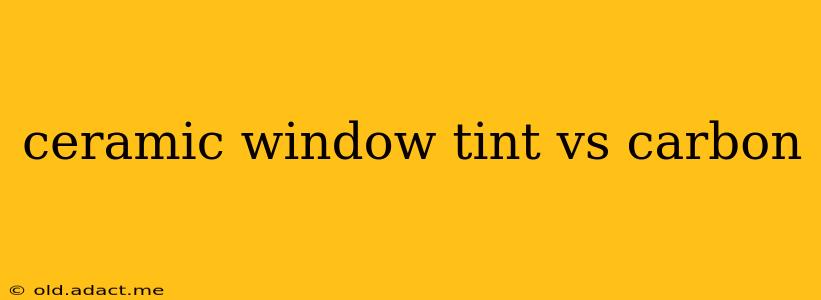Choosing the right window tint for your car or home can feel overwhelming. Two popular options are ceramic and carbon window tints, each boasting unique benefits and drawbacks. This comprehensive guide will delve into the key differences between ceramic and carbon window tint, helping you make an informed decision.
What is Ceramic Window Tint?
Ceramic window tint utilizes microscopic ceramic particles embedded within a polyester film. These particles block infrared (IR) light, which is the primary source of heat from the sun. Unlike dyed or metalized tints, ceramic tints offer superior heat rejection without compromising visible light transmission or creating signal interference. This makes them a popular choice for those prioritizing heat reduction and clear visibility.
Advantages of Ceramic Window Tint:
- Superior Heat Rejection: Ceramic tints excel at blocking infrared light, significantly reducing interior temperatures.
- Excellent UV Protection: They offer superior protection against harmful ultraviolet (UV) rays, safeguarding your skin and interior furnishings from sun damage.
- Signal Interference Free: Ceramic films generally do not interfere with cellular signals, GPS, or radio frequencies.
- Improved Aesthetics: They offer a clear, non-reflective appearance, maintaining the original look of your windows.
- Longer Lifespan: With proper care, ceramic tints are known for their durability and longevity.
Disadvantages of Ceramic Window Tint:
- Higher Cost: Ceramic window tints are generally more expensive than other types of film.
- Installation Complexity: The installation process can be more demanding, requiring skilled technicians.
What is Carbon Window Tint?
Carbon window tint utilizes layers of carbon-based materials to block solar energy. This type of tint offers a balance between heat rejection, UV protection, and cost. It's a popular alternative to metallic tints, offering better signal transmission than metallic options.
Advantages of Carbon Window Tint:
- Good Heat Rejection: Carbon tints provide effective heat rejection, although generally not as high as ceramic.
- Moderate UV Protection: They offer decent UV protection, helping shield your interior from sun damage.
- Improved Privacy: They offer a degree of privacy, darkening the interior of your vehicle or home.
- Cost-Effective: Carbon window tints are typically more affordable than ceramic options.
- Relatively Easy Installation: The installation process is generally simpler compared to ceramic tints.
Disadvantages of Carbon Window Tint:
- Less Effective Heat Rejection than Ceramic: Carbon tints don’t block infrared light as efficiently as ceramic.
- Potential for Signal Interference: While less than metallic tints, some signal interference is possible, depending on the specific product.
- Shorter Lifespan: Carbon tints generally have a shorter lifespan compared to ceramic tints.
- Appearance: Some carbon tints might have a slightly darker or less clear appearance than ceramic tints.
Ceramic Window Tint vs. Carbon Window Tint: A Comparison Table
| Feature | Ceramic Tint | Carbon Tint |
|---|---|---|
| Heat Rejection | Excellent | Good |
| UV Protection | Excellent | Moderate |
| Signal Interference | Minimal to None | Possible, but generally less than metallic |
| Cost | High | Moderate |
| Lifespan | Long | Moderate |
| Appearance | Clear, Non-reflective | Slightly darker, less clear |
Which is Right for You?
The best choice depends on your priorities and budget.
-
Choose ceramic tint if: You prioritize superior heat rejection, maximum UV protection, clear visibility, and long-term durability, and budget isn't a major constraint.
-
Choose carbon tint if: You need good heat rejection and UV protection at a more affordable price point, and don't require the absolute best performance.
How much does ceramic window tint cost?
The cost of ceramic window tint varies widely depending on several factors, including the quality of the film, the size of the windows being tinted, the installer's location and experience, and the complexity of the installation. Generally, you can expect to pay a higher price for ceramic tint than for other types, but the long-term benefits in heat reduction and durability often make it a worthwhile investment.
How long does ceramic window tint last?
With proper care and maintenance, high-quality ceramic window tint can last for many years, often 5-10 years or more. Its durability stems from the robust construction of the film and the inherent stability of the ceramic particles. However, the actual lifespan can be affected by factors like exposure to extreme weather conditions, improper cleaning, and accidental damage.
How long does carbon window tint last?
Carbon window tint typically has a shorter lifespan compared to ceramic, generally lasting 3-5 years. Its longevity is influenced by the same factors as ceramic tint – exposure to the elements, cleaning methods, and potential damage.
By understanding the pros and cons of each type, you can choose the window tint that best suits your needs and budget. Remember to consult with a reputable window tinting professional for personalized advice and installation.
